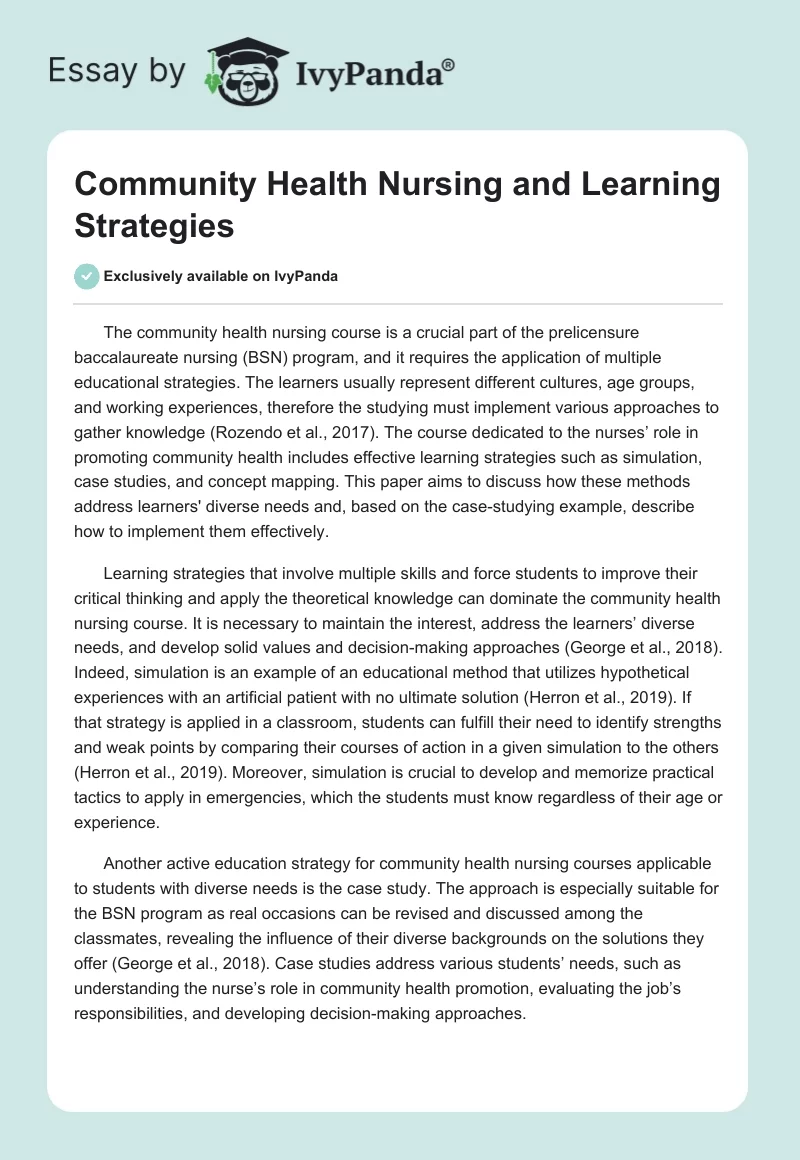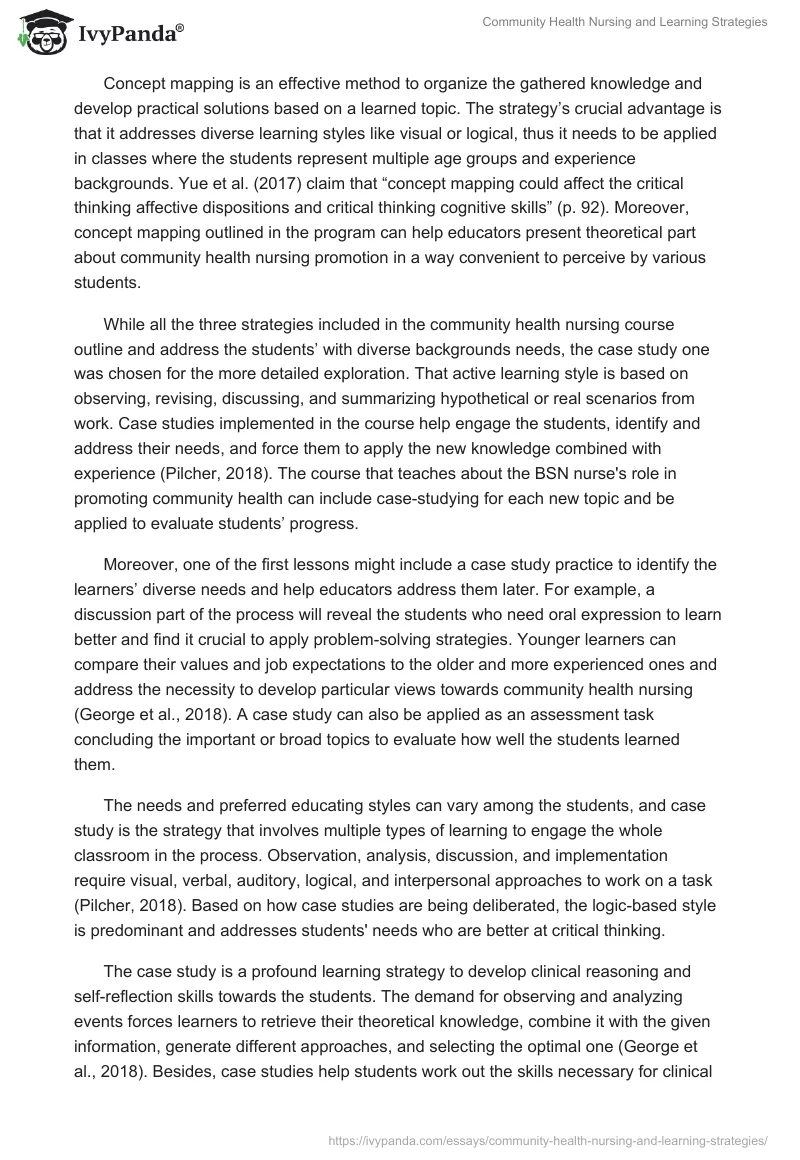The community health nursing course is a crucial part of the prelicensure baccalaureate nursing (BSN) program, and it requires the application of multiple educational strategies. The learners usually represent different cultures, age groups, and working experiences, therefore the studying must implement various approaches to gather knowledge (Rozendo et al., 2017). The course dedicated to the nurses’ role in promoting community health includes effective learning strategies such as simulation, case studies, and concept mapping. This paper aims to discuss how these methods address learners’ diverse needs and, based on the case-studying example, describe how to implement them effectively.
Learning strategies that involve multiple skills and force students to improve their critical thinking and apply the theoretical knowledge can dominate the community health nursing course. It is necessary to maintain the interest, address the learners’ diverse needs, and develop solid values and decision-making approaches (George et al., 2018). Indeed, simulation is an example of an educational method that utilizes hypothetical experiences with an artificial patient with no ultimate solution (Herron et al., 2019). If that strategy is applied in a classroom, students can fulfill their need to identify strengths and weak points by comparing their courses of action in a given simulation to the others (Herron et al., 2019). Moreover, simulation is crucial to develop and memorize practical tactics to apply in emergencies, which the students must know regardless of their age or experience.
Another active education strategy for community health nursing courses applicable to students with diverse needs is the case study. The approach is especially suitable for the BSN program as real occasions can be revised and discussed among the classmates, revealing the influence of their diverse backgrounds on the solutions they offer (George et al., 2018). Case studies address various students’ needs, such as understanding the nurse’s role in community health promotion, evaluating the job’s responsibilities, and developing decision-making approaches.
Concept mapping is an effective method to organize the gathered knowledge and develop practical solutions based on a learned topic. The strategy’s crucial advantage is that it addresses diverse learning styles like visual or logical, thus it needs to be applied in classes where the students represent multiple age groups and experience backgrounds. Yue et al. (2017) claim that “concept mapping could affect the critical thinking affective dispositions and critical thinking cognitive skills” (p. 92). Moreover, concept mapping outlined in the program can help educators present theoretical part about community health nursing promotion in a way convenient to perceive by various students.
While all the three strategies included in the community health nursing course outline and address the students’ with diverse backgrounds needs, the case study one was chosen for the more detailed exploration. That active learning style is based on observing, revising, discussing, and summarizing hypothetical or real scenarios from work. Case studies implemented in the course help engage the students, identify and address their needs, and force them to apply the new knowledge combined with experience (Pilcher, 2018). The course that teaches about the BSN nurse’s role in promoting community health can include case-studying for each new topic and be applied to evaluate students’ progress.
Moreover, one of the first lessons might include a case study practice to identify the learners’ diverse needs and help educators address them later. For example, a discussion part of the process will reveal the students who need oral expression to learn better and find it crucial to apply problem-solving strategies. Younger learners can compare their values and job expectations to the older and more experienced ones and address the necessity to develop particular views towards community health nursing (George et al., 2018). A case study can also be applied as an assessment task concluding the important or broad topics to evaluate how well the students learned them.
The needs and preferred educating styles can vary among the students, and case study is the strategy that involves multiple types of learning to engage the whole classroom in the process. Observation, analysis, discussion, and implementation require visual, verbal, auditory, logical, and interpersonal approaches to work on a task (Pilcher, 2018). Based on how case studies are being deliberated, the logic-based style is predominant and addresses students’ needs who are better at critical thinking.
The case study is a profound learning strategy to develop clinical reasoning and self-reflection skills towards the students. The demand for observing and analyzing events forces learners to retrieve their theoretical knowledge, combine it with the given information, generate different approaches, and selecting the optimal one (George et al., 2018). Besides, case studies help students work out the skills necessary for clinical reasoning, such as critical thinking and evidence assessment. Self-reflection is involved in that learning strategy as the discussion part can give the basis to compare the level of knowledge among the learners and help them discover weak points.
Community health promotion is crucial for society, and the nurse’s role in it cannot be underestimated as such responsibility requires developed analytical, clinical thinking, and self-reflection and skills. Students who attend a course for the BSN program might have diverse backgrounds, needs, and learning styles, therefore the studying process must be organized in various ways. The program outline can include simulation to show practical solutions, case studies to engage students in the discussion, develop their critical thinking, and concept mapping to properly gather the theoretical information.
References
George, T. P., DeCristofaro, C., Murphy, P. F., & Remle, C. R. (2018). Knowledge, attitudes, and experience with advance directives among prelicensure nursing students.Journal of Nursing Education, 57(1), 35-39. Web.
Herron, E. K., Powers, K., Mullen, L., & Burkhart, B. (2019). Effect of case study versus video simulation on nursing students’ satisfaction, self-confidence, and knowledge: A quasi-experimental study. Nurse Education Today, 79, 129-134. Web.
Pilcher, J. (2018). Promoting learning using case-based strategies in nursing professional development. Journal for Nurses in Professional Development, 34(4), 199-205. Web.
Rozendo, C. A., Salas, A. S., & Cameron, B. (2017). A critical review of social and health inequalities in the nursing curriculum. Nurse Education Today, 50, 62-71. Web.
Yue, M., Zhang, M., Zhang, C., & Jin, C. (2017). The effectiveness of concept mapping on development of critical thinking in nursing education: A systematic review and meta-analysis. Nurse Education Today, 52, 87-94. Web.


